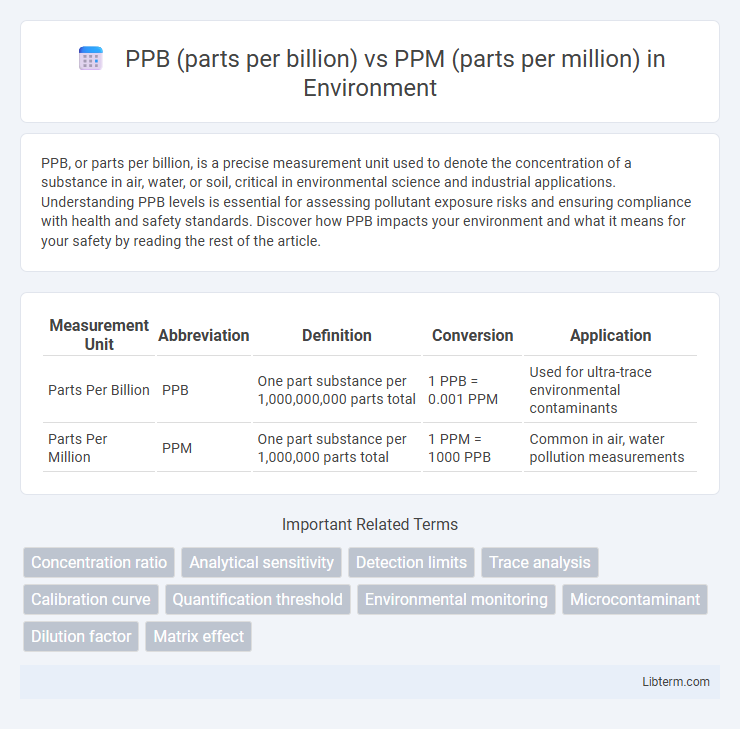PPB, or parts per billion, is a precise measurement unit used to denote the concentration of a substance in air, water, or soil, critical in environmental science and industrial applications. Understanding PPB levels is essential for assessing pollutant exposure risks and ensuring compliance with health and safety standards. Discover how PPB impacts your environment and what it means for your safety by reading the rest of the article.
Table of Comparison
| Measurement Unit | Abbreviation | Definition | Conversion | Application |
|---|---|---|---|---|
| Parts Per Billion | PPB | One part substance per 1,000,000,000 parts total | 1 PPB = 0.001 PPM | Used for ultra-trace environmental contaminants |
| Parts Per Million | PPM | One part substance per 1,000,000 parts total | 1 PPM = 1000 PPB | Common in air, water pollution measurements |
Understanding PPB and PPM: Basic Definitions
PPB (parts per billion) and PPM (parts per million) are units of measurement used to express the concentration of a substance in air, water, or soil. PPM denotes one part of a substance per one million parts of the total, while PPB represents one part per one billion parts, making PPB a thousand times more precise than PPM. These units are essential for accurately quantifying trace levels of contaminants or chemicals in environmental science, chemistry, and engineering.
The Mathematical Difference: PPB vs PPM
PPB (parts per billion) quantifies concentration as one part substance per 1,000,000,000 parts solution, while PPM (parts per million) measures one part per 1,000,000 parts solution. Mathematically, 1 PPM equals 1,000 PPB, indicating PPB provides a finer scale for detecting lower concentrations. This ratio is essential in environmental science, water quality testing, and pollution monitoring where precision at extremely low levels matters.
Units and Symbols: How PPB and PPM are Expressed
PPB (parts per billion) and PPM (parts per million) are units used to express very dilute concentrations, where 1 PPM equals one part substance per one million parts of the total, symbolized as ppm, and 1 PPB equals one part substance per one billion parts of the total, symbolized as ppb. These units are dimensionless ratios often used in environmental science, chemistry, and engineering to specify concentrations of contaminants or pollutants in air, water, or soil. Precise representation of ppm and ppb with lowercase letters is critical for standardization and clarity in scientific communication and data reporting.
Common Applications of PPB and PPM Measurements
PPB (parts per billion) and PPM (parts per million) are critical units for measuring concentrations in environmental monitoring, water quality testing, and air pollution analysis. PPB is commonly used for detecting trace contaminants such as heavy metals, pesticides, and volatile organic compounds in drinking water and soil samples. PPM measurements are frequently applied in industrial processes, chemical manufacturing, and gas concentration monitoring where higher concentration levels are expected.
Conversion Between PPB and PPM: Simple Formulas
PPB (parts per billion) and PPM (parts per million) are units used to measure the concentration of substances, where 1 PPM equals 1,000 PPB. To convert PPB to PPM, divide the PPB value by 1,000, while multiplying a PPM value by 1,000 converts it to PPB. These simple formulas facilitate precise quantification in environmental science, chemistry, and engineering applications.
PPB vs PPM in Environmental Testing
Parts per billion (PPB) and parts per million (PPM) are critical units in environmental testing, with PPB representing a concentration 1,000 times smaller than PPM. PPB measurements are essential for detecting trace levels of contaminants such as heavy metals and pesticides in water, air, and soil, where even minute quantities can pose significant health risks. Environmental laboratories utilize PPB over PPM when regulatory standards demand higher sensitivity for pollutants, ensuring precise compliance with safe exposure limits.
Importance in Water and Air Quality Analysis
PPB (parts per billion) and PPM (parts per million) are critical units for measuring contaminant concentrations in water and air quality analysis, with PPB representing a thousandfold finer resolution than PPM. Regulatory agencies, such as the EPA and WHO, often set maximum contaminant levels in PPB to detect trace amounts of pollutants like lead, mercury, and volatile organic compounds that pose significant health risks even at very low concentrations. Accurate detection at PPB levels ensures early identification and mitigation of hazardous substances, safeguarding public health and maintaining environmental standards.
Accuracy and Sensitivity: Which to Use and When
PPB (parts per billion) offers higher sensitivity than PPM (parts per million), making it ideal for detecting trace contaminants in environments requiring precise measurements, such as drinking water analysis or air quality monitoring. PPM is suitable for less sensitive applications where approximate concentration levels suffice, like industrial emissions or soil testing. Choosing between PPB and PPM depends on the required accuracy and detection limits of the analytical method applied in the specific environmental or scientific context.
Industry Standards and Regulatory Limits
Industry standards and regulatory limits frequently differentiate between PPB (parts per billion) and PPM (parts per million) to ensure precise contaminant control, especially in sectors like environmental monitoring and pharmaceuticals. PPB is used for ultra-trace level detection where regulatory bodies such as the EPA and FDA set stringent thresholds, often below 1 PPM, to ensure safety and compliance. PPM measurements are more common in industrial processes with higher tolerance levels, facilitating standardized quality control and pollutant emissions monitoring within defined regulatory frameworks.
Conclusion: Choosing Between PPB and PPM
PPB (parts per billion) offers greater precision than PPM (parts per million), making it ideal for measuring extremely low concentrations in environmental monitoring and trace chemical analysis. PPM is more practical for higher concentration levels, such as industrial chemical processes and water quality assessments. Choosing between PPB and PPM depends on the sensitivity required in the measurement and the specific application's regulatory standards.
PPB (parts per billion) Infographic

 libterm.com
libterm.com